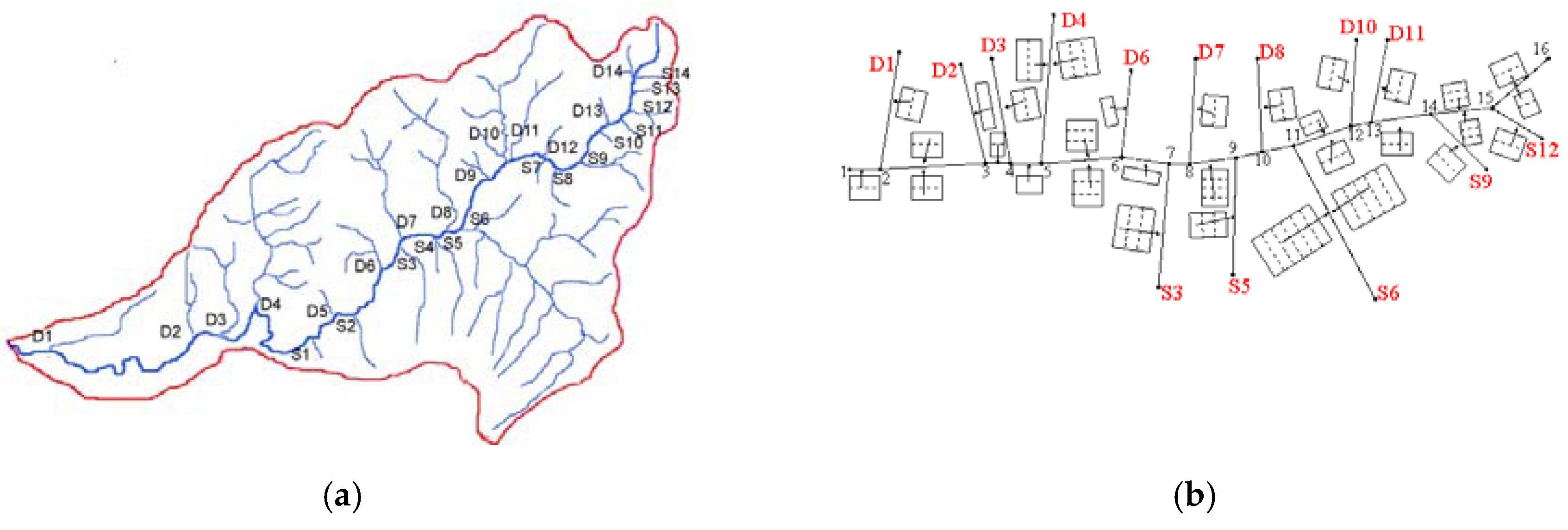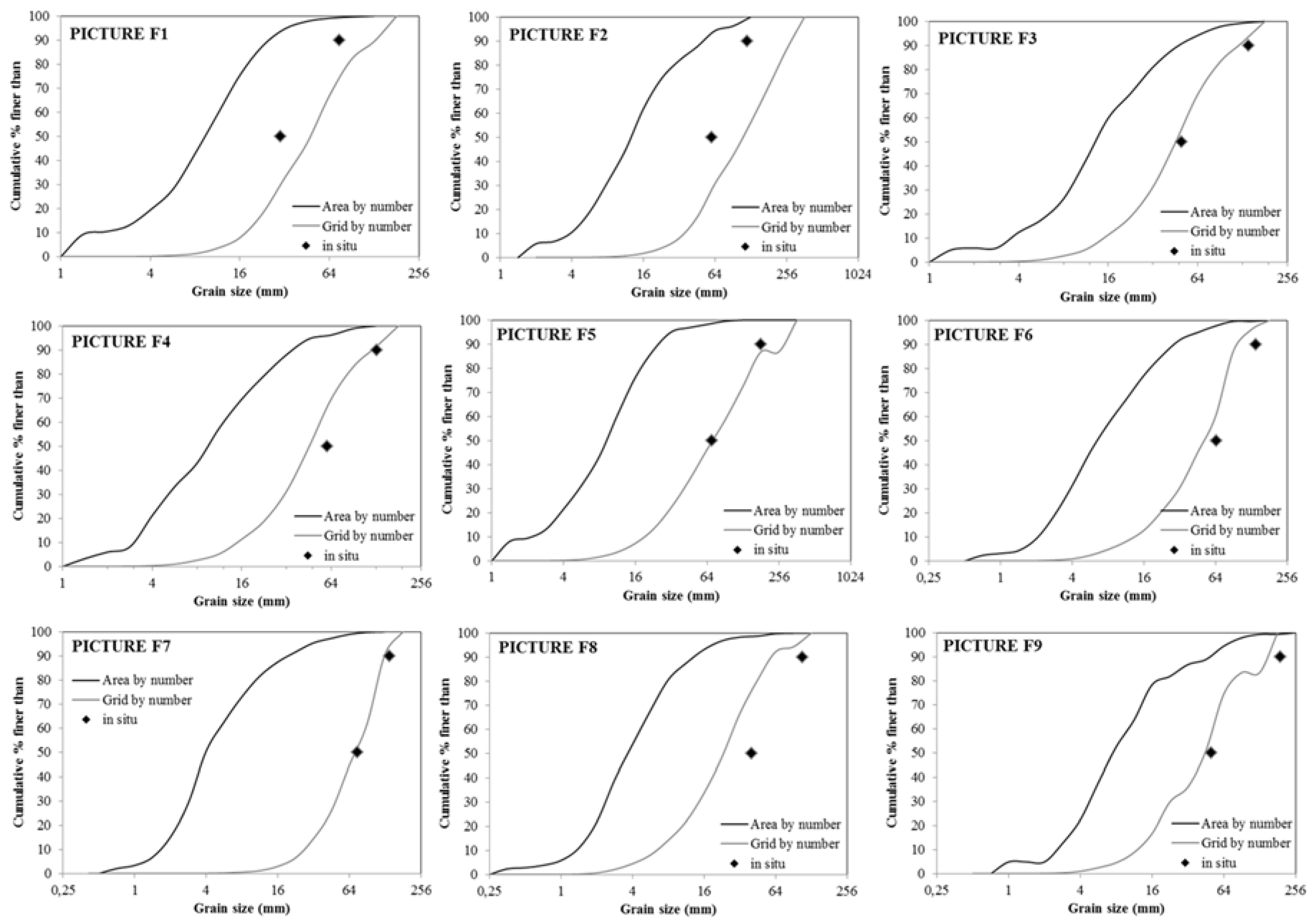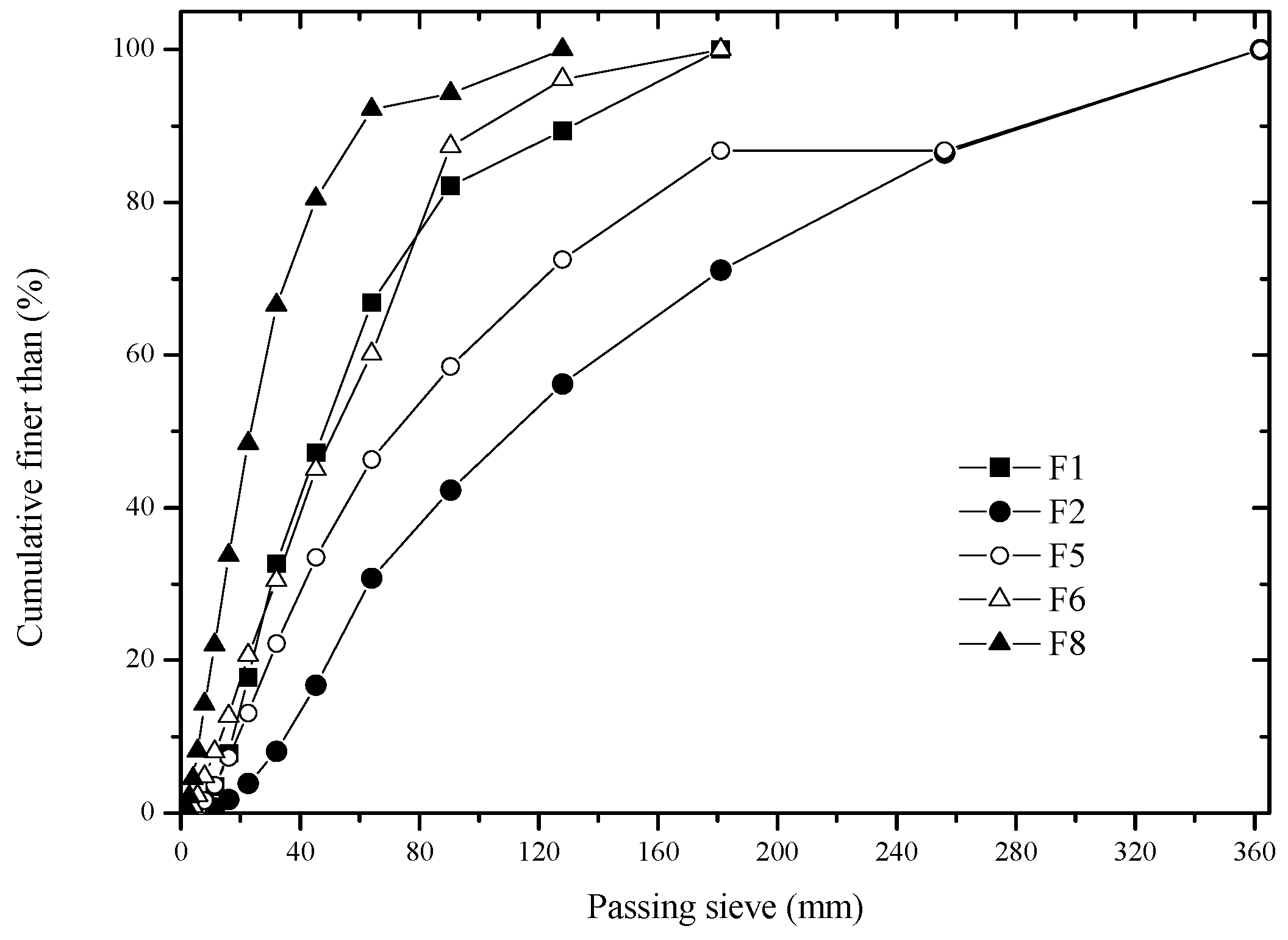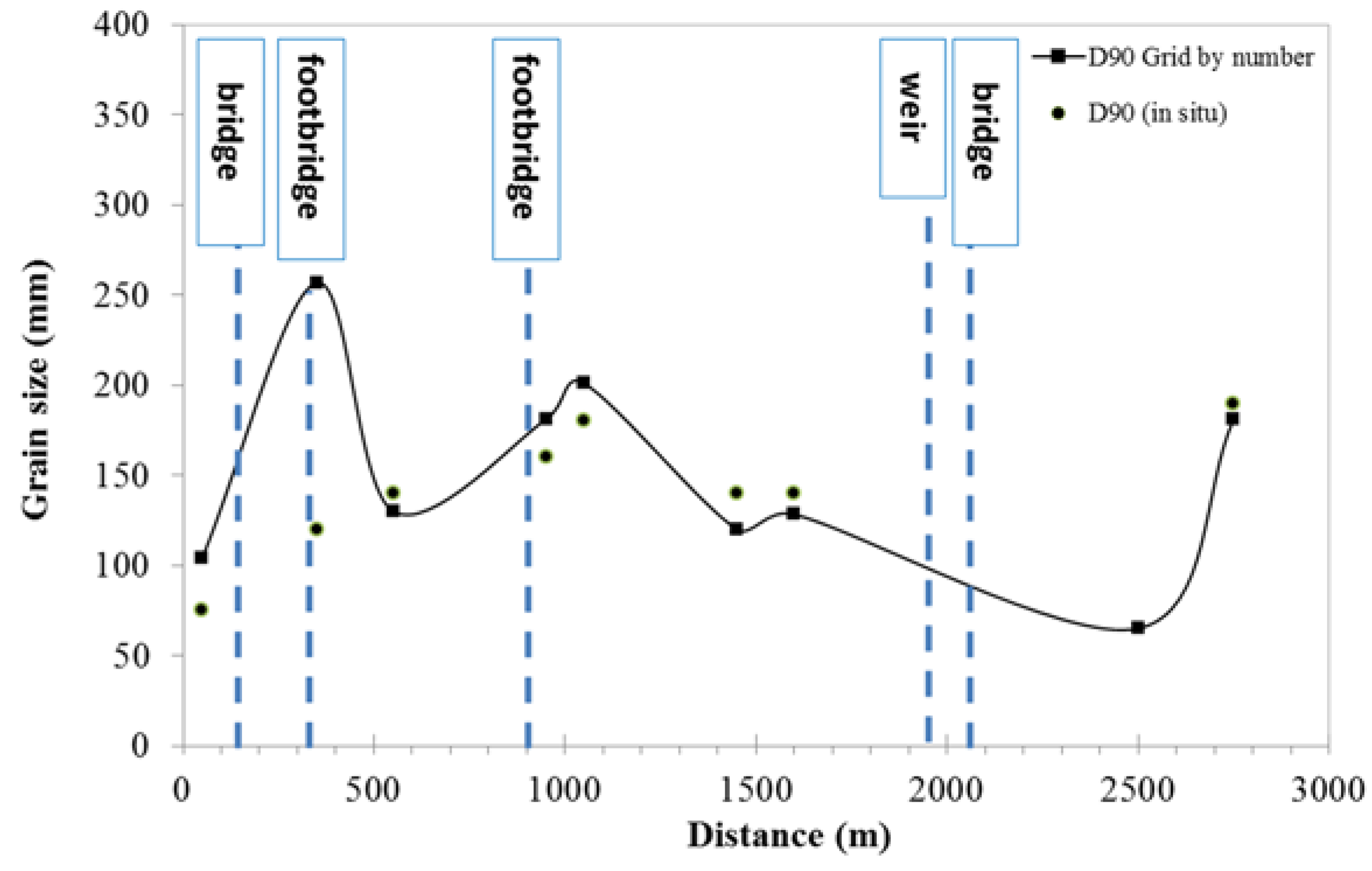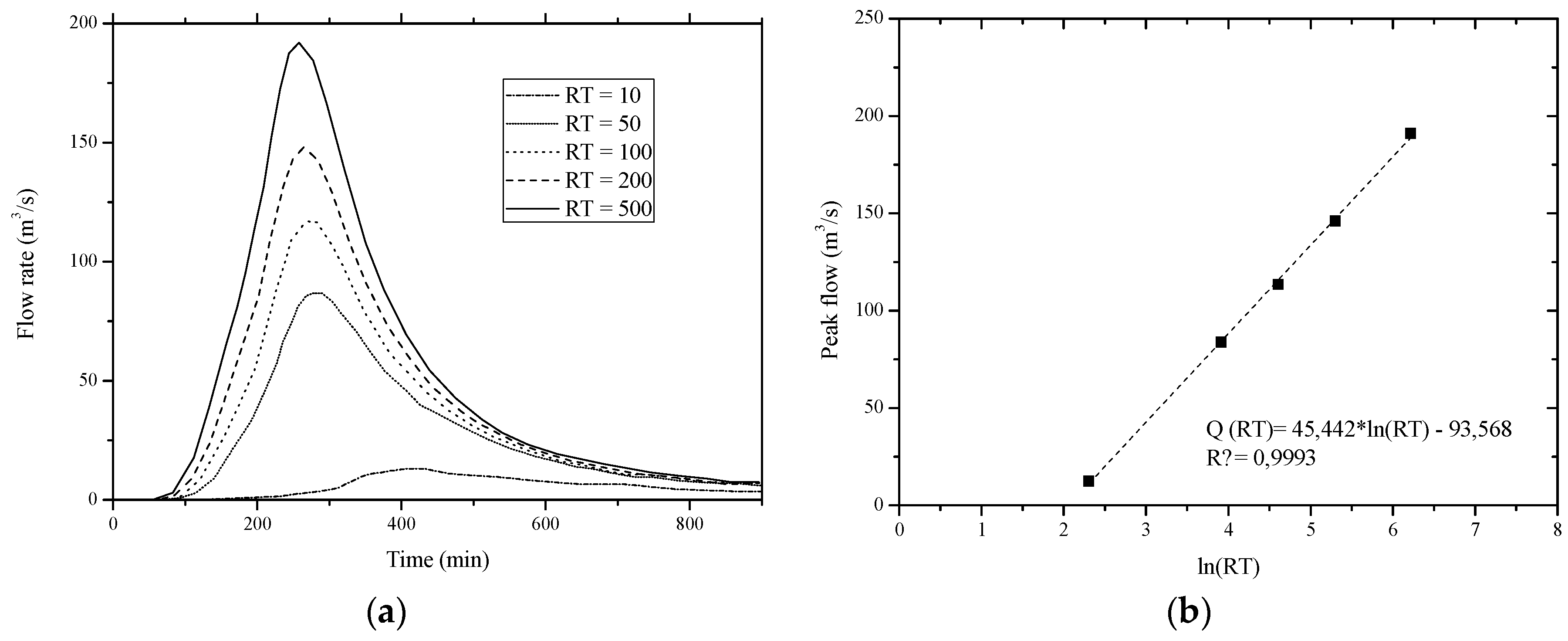Thanks to a number of surveys made on site, it was possible to identify and determine the conditions of erosion and instability of the riverbed. Given the purpose of this work, it is worth noting the situation observed in the riverbed in a cross section located at about 1600 m (Section F7) from the confluence with the Chiascio River. There, an analysis of the sediments could be performed and the geometry of the section taken over when the riverbed was dry.
Through the monitoring done in the investigated river reach in dry conditions, the armor removal was only detected in this cross section. In fact, if the erosive event is sufficiently important, the state of the riverbed could be considered as a footprint, a snapshot that retains traces of the most significant floods recognizable with prolonged observation in time, and this is especially true for rivers with torrential water currents, such as the one analyzed in the present paper. It can be assumed that the observed erosion is a direct result of a flood wave propagation, as the hydraulics of the river reach under investigation are not affected by other relevant factors that may have contributed to the erosion of riverbed. Note that section F7 is representative of a river reach characterized by a regular cross-section, an almost constant slope, and a low sinuosity. Moreover, no significant obstacles (e.g., trees), bank erosions or anthropogenic changes are present. It can also be observed that the hydraulics of such a stretch is not affected by possible backwater caused by the confluence with the Chiascio River, which is about 1600 m downstream, or by river flow modifications caused by the human artifacts (i.e., the closest is the Tescio Bridge, which is about 500 m upstream).
4.1. Flood Event Characterization
The main objective of the present study is to calculate the average mass flow rate associated to a flood event, starting from the erosion caused by the flood event and observed in the river section. Such an assessment is performed through the adoption of sediment transport analytical formulations.
The solid transport relationships clearly show that the smaller the grain size, the greater the transport capacity of the flow. Therefore, in natural streams, small particles are transported downstream faster than large ones. Such an effect is mitigated by the mixing of the materials coming from upstream and by the action of larger grains that shelter the finer substrate grains from entrainment. The above phenomenon, usually called armoring, determines the particle size distribution over the riverbed with a coarse surface layer (i.e., armor layer) on the bed surface [
37,
38]. On the other hand, armor layers break-up under the action of important flood events [
39,
40] and an estimate of the moved material could allow for the characterizing the flood event itself.
The following model is that proposed Meyer-Peter et al. [
41], obtained by interpreting the results of extensive experimental research conducted in the laboratory of outflowing currents in uniform flow conditions and, mainly, with monogranular materials. In particular, it can be assumed that the volumetric flow rate of the sediment transport per unit length,
qs, is a function of the water flow rate, the grain diameter,
d; the solid material density, ρ
s; and the Shields parameter or criterion, ψ which measures the beginning of the motion of the sediment flow. This allows calculating
qs through the following relationship:
where
g is the gravity acceleration, ψ is the Shields parameter on the bottom of the riverbed and ψ
cr is the critical Shield parameter calculated at the incipient motion flow conditions.
Given the flood duration,
T, assessed in two hours, and the volume of the moved sediments per unit length,
Ws, estimated in 3 m
2, the average value of
qs was calculated as follows:
The above expression, however, assumes that the eroded material has a uniform grain size distribution, which is not true for real riverbeds. Therefore, it is necessary to employ a relationship that calculates the overall solid flow rate by weighting the flow rates,
qsi, associated with the different grain diameters,
di, as follows:
where the weights,
pi, need to be calculated.
The evaluation of the incipient motion is performed by imposing the dynamic equilibrium between the forces acting on the grains invested by the flow [
42] as follows:
where
is the friction velocity, calculated as:
In Equation (4), τ0 is the total bed critical shear stress on the wetted perimeter.
The function ψ is evaluated through the Shields diagram [
43], which was experimentally derived and is typically used to identify the initiation of the sediment motion, by relating the dimensionless shear stress (also known as Shields stress) necessary to cause sediment movement with the grain shear Reynolds number, Re*, calculated as:
where ν is the kinematic viscosity of water.
The Shields diagram separates the motion area from the still one: the points that lie below the boundary curve identify the condition when the motion of the water is not sufficiently high to move the grains (ψ < ψcr), while the points that lie above the curve represent the sediment movement conditions.
The value of ψ
cr is here calculated as a function of the grain characteristic length in incipient motion conditions through the Brownlie fit of the Shields diagram [
43]:
where
is a characteristic diameter defined as follows:
As already discussed, natural waterways are characterized by a riverbed bottom with heterogeneous granulometry, which has a different behavior, in the evaluation of incipient motion of sediments particles with respect to a bed consisting of homogeneous material. The mobility of smaller grains is reduced by the sheltering effect of larger stones that in turn have their mobility increased by their greater exposure. The change in the Shields parameter with the size of the particles constituting the sediment,
di, is controlled by the hiding function:
here calculated through the empirical formulations proposed by Hayashi et al. [
44]:
As proposed by Egiazaroff [
45],
da was calculated as the weighted average of the grain diameters:
Then, the weights,
pi, were estimated by counting the number of grains of equal characteristics through the areal-based procedure previously described.
Table 4 reports the measured grain distribution, from which
da results as equal to 90.33 mm.
The sediment transport value relative to the diameters di can be calculated using Equation (1).
Given the structure of the river reach under investigation, the piezometric surface,
j, can be assumed to be equal to the slope of the bottom of the riverbed,
i. Therefore, ψ
i can be derived from Equation (12) as follows:
In which γ is the specific weight of water and R is the hydraulic radius of the river section. By estimating ψi through the Shield’s diagram, it is possible to calculate R = 0.862 m and τ0 = 73.53 Pa from Equation (12).
Following this, we applied the Chézy’s formula, which describes the mean flow velocity of steady-state turbulent open channel flows, to calculate the flow discharge, Q, by assuming a Manning’s roughness coefficient equal to 0.04 s/m1/3. It results that the flow rate that caused the erosion during the flood event of known duration is about 22 m3/s.
By linearly interpolating the hydrographs obtained through the hydrological analysis, the hydrographs in the river section under investigation for different return periods were obtained, as depicted in
Figure 14a.
Figure 14b shows the peak flow rates as a function of the return period and the corresponding linear regression, which, in turn, allows for a calculation of a return period of 13 years associated with a flood discharge of 22 m
3/s.
4.2. Hydraulic Analysis and Procedure Validation
A validation of the above procedure is here performed through the hydraulic numerical simulation of the river basin under investigation. In particular, the Hec-Ras software was employed to calculate the water depth and the flood areas at different return periods (i.e., 50, 100, 200 and 500 years). The employed numerical modeling is based on a one-dimensional steady flow. Energy losses were calculated through Manning’s equation. Consistent with the approximation of the proposed procedure, the hydraulic analysis was carried out at a fixed riverbed, based on the pre-flood geometry. In the river sections where the current varies rapidly (e.g., bridges, hydraulic jumps, and weirs), the model solves the momentum equation.
The other input data necessary for the hydraulic simulations include geometric data, such as cross section profiles and the slope of the river reach, roughness coefficients, and inlet and outlet boundary conditions (i.e., flow discharges). In particular, the hydraulic simulation was performed in a 13 km long river reach, in order to avoid effects of the boundary conditions, and 72 cross sections were surveyed. Moreover, the water discharges at the different RTs are directly drawn from the results of the hydrologic analysis reported in
Section 2.
The results of the hydraulic simulations for the cross section under investigation are reported in
Table 5, where the water discharges at different RTs are also associated to different critical shear stresses.
The hydraulic effects on the grain size distribution are evidenced by the data summarized in
Table 6, which reports the
d50 and
d90 values of the nine cross sections under investigation together with the critical shear stress, the flow velocity, and the wetted area. In particular, it can be observed that, as a general trend,
d50 and
d90 increase with the shear stress and decrease with the wetted area. However, it should be noted that such a relationship is more complex, as differences in grain size with the same shear stress may also be observed locally, as for example in section F2, which has the same
τ as section F5, with a comparable
d50 but almost double the
d90.
Through the hydraulic simulations, the relationship between
Q and τ
0 in section F7 was constructed, as depicted in
Figure 15. From this relationship, a critical shear stress of 74.79 Pa associated to the flow discharge of the flood event equal to 22 m
3/s was calculated. Such a value is in excellent agreement with that calculated through Equation (12) (τ
0 = 73.53 Pa).
